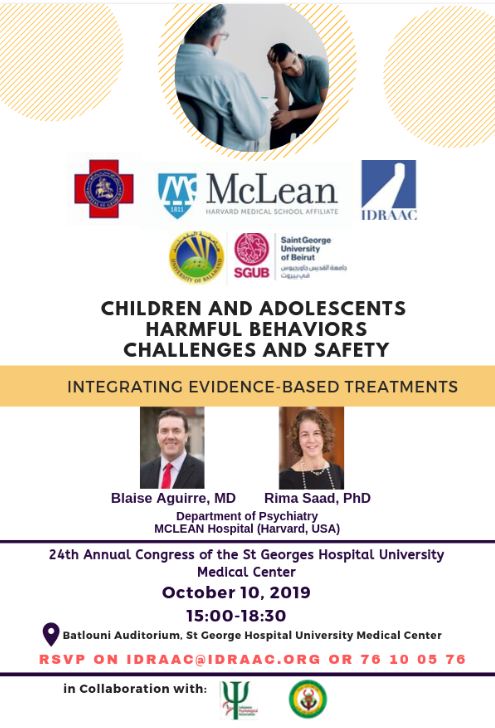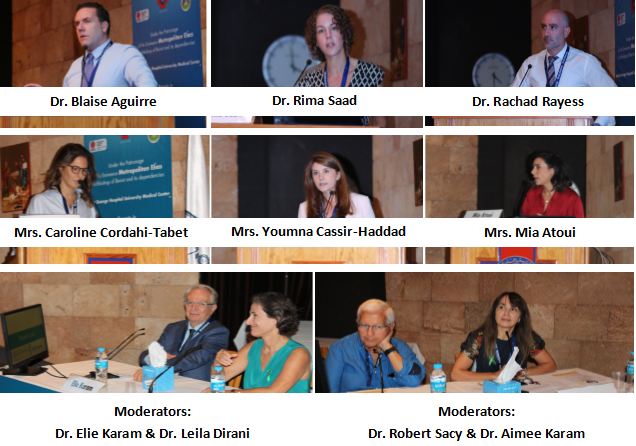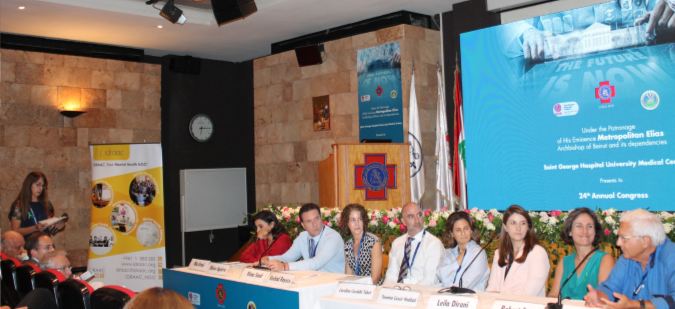
On the occasion of World Mental Health Day, IDRAAC, in collaboration with the Department of Psychiatry and Clinical Psychology of the St George Hospital University Medical Center, McLean Hospital – Harvard, the Lebanese Psychological Association and the Lebanese Psychiatric Society, organized this conference as part of the 24th Annual Congress of the St George Hospital University Medical Center on Thursday October 10, 2019 at 3:00pm at the Batlouni Auditorium.
The conference hosted Dr. Blaise Aguirre & Dr. Rima Saad from McLean Hospital- Harvard (which is well-known for excellent clinical and academic work) who discussed the latest evidence-based treatments for harmful behaviors in children, adolescents and young adults.
On the panel, Lebanese psychologists and psychiatrists have highlighted that maladaptive behaviors are not a choice, they are incapacities requiring specific interventions. The importance of how to assess and when to assess, and the different characteristics of suicidal ideation. The concept of bullying, how to define it and the related pathologies around this behavior was highlighted, in particular the value of a good definition that will determine evidence-based treatment, self-injurious behavior in the autism spectrum disorders and their treatment were also discussed. Embrace’s vision and outcomes were also exposed.
Around 240 attendees from various backgrounds attended the conference.
You can check below the main points discussed by the speakers in each session.
You can also check the press coverage on this link.
Session 1
During the first session, moderated by IDRAAC’s president Dr. Elie Karam and Dr. Leila Dirani from the American University of Beirut Medical Center, Dr. Blaise Aguirre, Medical Director of McLean Hospital’s 3East Continuum and Assistant Professor of Psychiatry at Harvard Medical School, discussed “Integrating Dialectical Behavioral Therapy in an Adolescent Young Adult Psychiatric Setting”. He explained that suicide is a significant concern affecting young people all over the world and that the main target for suicidal adolescents, is difficulty in regulating emotions. Emotions regulation difficulties are a manifestation of a skills deficit, and the most effective way to change a maladaptive behavior is to teach an adaptive one.
Dr. Aguirre noted that many systems have a revolving door approach to treating people with suicidal behaviors. Dialectical behavior therapy (DBT) has a large evidence base for efficacy in targeting patients suffering from emotional regulation and distress intolerance, in particular suicidality and self-injurious behaviors. He explained that DBT is a type of treatment that focuses on skill-building in the following areas: Mindfulness, Interpersonal Effectiveness, Emotion Regulation and Distress Tolerance. He added that the goal of DBT treatment is to enact change that supports new ways of thinking, of managing emotions, of relating to others and of dealing with distress.
Dr. Rima Saad, Assistant Professor of Psychology at the Department of Psychiatry at Harvard Medical School and Director of McLean Hospital’s Middle East Center for Culturally Informed Care & Director of Behavioral and Group Therapy Services, focused on the behavioral therapies: individual and group therapy programming. Her presentation focused on the challenge of integrating evidence based behavioral approaches into a complex hospital setting with multiple therapeutic modalities.
Collaborative attitude in a well trained multidisciplinary team, identification of the most appropriate intervention and commitment of patients increase the efficiency of behavioral therapies at a higher level of care.
She explained that behavioral therapies can offer hands on, present focused interventions for both clinicians and patients dealing with life threatening and treatment interfering behaviors and can be integrated into individual and group programming at different levels of care. In addition, behaviorally oriented group therapy functions to teach concepts and initiate knowledge acquisition, and individual behavioral therapy consolidates knowledge and helps patients generalize their use of skills.
For his part, Dr. Rachad Rayess, child and adolescent psychiatrist at the St George Hospital University Medical Center and IDRAAC, gave a clinical perspective of “Understanding Ideation of Harm in Adolescents”. He explained that suicidal ideation in adolescents is a complex and important topic for clinicians working in the mental health field. It is critical to be able to understand the difference between acute and chronic suicidal ideation, to tell whether the adolescent is expressing active versus passive suicidal thoughts, and to tease out suicidal from parasuicidal ideation. He stressed on the importance of history taking, including prior history of suicidal ideation, substance use history and family history, and described it as a vital part of assessing risk. He concluded that once the assessment of risk has been done, next comes clinical intervention, where several steps can be taken to help reduce risk of harm.
Session 2
The second session was moderated by Dr. Aimée Nasser Karam, Adult Clinical Psychologist at the St George Hospital University Medical Center, IDRAAC and President of the Lebanese Psychological Association and Dr. Robert Sacy, Pediatrician at the St George Hospital University Medical Center.
Caroline Cordahi-Tabet, Child and Adolescent Clinical Psychologist at the St George Hospital University Medical Center and IDRAAC talked about “Self-Harm and Bullying”. She discussed the available data to understand the potential relationships between self-harm behavior and bullying, in bullies, victims and / or bully-victims. Findings demonstrate that involvement in any role of bullying is, to a certain extent, associated with self-harm, suicidal ideation and behavior. She added that bullies are at risk to cause serious harm to others, but also to themselves adding that Cyber bullying is clearly not to be neglected. She also noted that mental health seems to remain the primary risk factor related to the severity of harm. It is important to assess it in any type of bullying. The most complex cases seem to be the bully-victims, but the bullies themselves are at high risk.
She also mentioned that IDRAAC is conducting a study on bullying in a sample of 313 outpatients (age 9-18) with mental health conditions.
Youmna Cassir Haddad, Child and Adolescent Psychologist at the St George Hospital University Medical Center and IDRAAC presented the issue of “Self-Harm and Autism Spectrum, developmental delays and intellectual disabilities”. She addressed the association of self-injurious behaviors (SIB) with Autism spectrum and other intellectual disabilities. She explained that self-injurious behaviours (SIB) are among the concomitant symptoms of Autism Spectrum Disorders (ASD). SIB involves any kind of behaviour that have the potential to produce harm for the person doing the behaviour. The most common forms of SIB are self-biting, self-scratching, skin picking, self-punching and head banging. These behaviours are highly repetitive, and frequencies are up to dozens of instances per minute.
She finally discussed the functional analysis of SIB and presented some behavioral interventions strategies.
Mia Atwi, clinical psychologist and co-founder of Embrace (Lebanon’s National Emotional Support and Suicide Prevention Hotline), reviewed the history of Embrace, its development and function. She noted that suicide is quickly becoming a major public health concern in Lebanon, with one person dying of suicide every 2.5 days and one person attempting suicide every 6 hours. Globally, suicide is the second leading cause of death among persons aged 15 to 29.
Embrace launched in 2017 the first national helpline for suicide prevention and emotional support, in partnership with the Ministry of Public Health, she mentioned that 25% of all calls to this helpline, since its initiation, were from an adolescent and young adult population (age 13-21 years old), for emotional problems, and not necessarily for suicide. The data has shown that most calls received are from the Beirut region, with the majority of calls from adolescents struggling with emotional distress (70%).
According to Atwi, there are several important risk factors for suicidal ideation that are highlighted among this population, such as the presence of a mental illness, social isolation, chronic experience of major stressors, family discord being the most prominent risk factor. The data from the helpline has also shown that family support and social support are considerably the leading protective factors.
The conference ended with a roundtable moderated by Dr. Aimee Karam with the following recommendations: the importance of increasing connectivity and talking about self-harm, training of professionals, validating painful emotions, enhancing emotional resilience and support, being aware of how media is portraying facts and realities and increasing mental health awareness and access.

